A Thing of Beauty…
Graham Falvey visits the Chauvet Caves in Southern France


A Thing of Beauty…
Graham Falvey visits the Chauvet Caves in Southern France
These extraordinary vivid images of horses and other animals are found in the Chauvet-Pont-d’Arc Cave in the Ardèche department of Southern France. They were discovered in 1994 by speleologists who had used lighter flames to locate up-draughts indicating a possible cave opening. Immediately after the discovery, the entrance was sealed with a metal grill, for the authorities had learned from experience at other previously discovered caves – such as those at Lascaux in the Dordogne – that respiration from visitors caused damage to the paintings due to mould. What can be visited today is a full-sized facsimile of the original. The Pont d’Arc Cavern replica was opened to the general public on 25 April 2015, and is the largest cave facsimile ever built worldwide, being ten times bigger than the one at Lascaux.
The cave is not the only wonder in the area. The Pont d’Arc is a large natural bridge 5km from the town of Vallon Pont d’Arc, carved out by the Ardèche River; it is 60m wide and 54m high. Originally, this would have been a solid limestone escarpment which deflected the course of the river. But constant erosion eventually opened a gap, leaving the bridge above it and allowing the river’s present course.
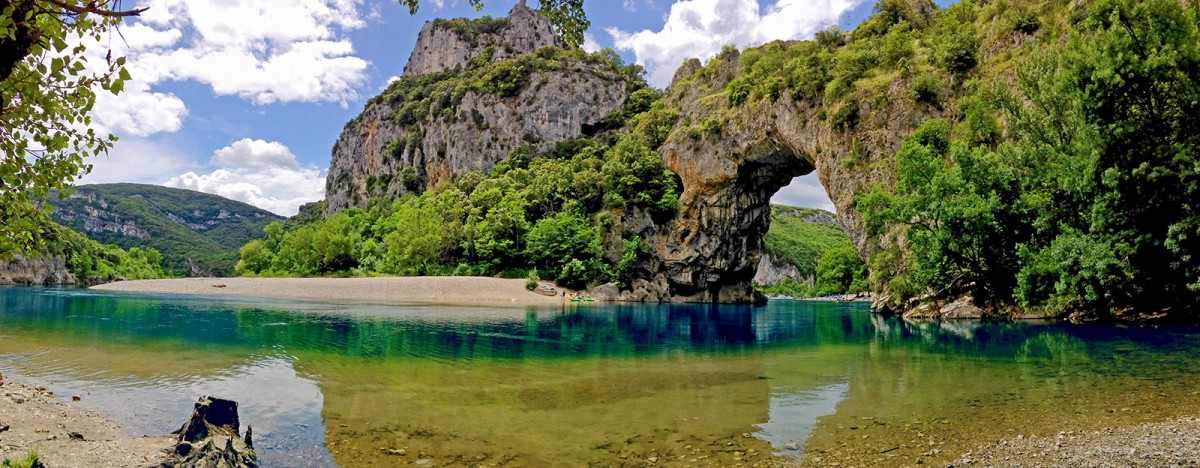
Pont d’Arc on the Ardèche River. Photograph by FotoGrafKoks, CC BY-SA 3.0, via Wikimedia Commons
The cave is uncharacteristically large in comparison with the many others in the region and is situated above the previous course of the Ardèche River before the Pont d’Arc opened up. It has an interesting history, being only ever visited but not inhabited by humans. It seems that the permanent occupants were various species of animal, including bears and hyenas, as no human bones were found there; 90% of the skeletons found are from bears, and the rest – wolves, ibex, horses, etc – may have been brought in by them.
Dates for the cave’s usage vary. According to Jean Clottes, the eminent prehistorian who was one of the first people to visit the cave in 1994:
Based on radiocarbon dating the cave appears to have been used by humans during two discrete periods: the Aurignacian and the Gravettian. Most of the artwork dates to the earlier Aurignacian era (30,000 to 32,000 years ago). The later Gravettian occupation which occurred 25,000 to 27,000 years ago left little but a child’s footprints, the charred remains of ancient hearths and carbon smoke stains from torches that lit the caves.
Following this second period, the cave entrance was blocked by a number of landslides; the first blocked entry to the larger mammals, whilst the second and third completely covered the entrance, preserving everything inside until their discovery at the end of the twentieth century.

Interior of the Chauvet Cave. Photograph by Claude Valette, CC BY-SA 4.0, via Wikimedia Commons
The Paintings
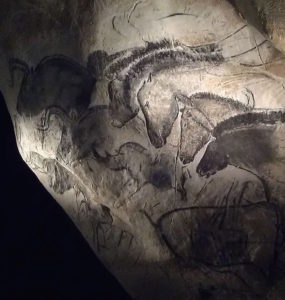 The paintings themselves are some of the earliest known and best preserved examples of Paleolithic art in the world. They are especially interesting because the artists used techniques not found elsewhere in Europe. There are examples of the use of perspective, abstract markings, and the natural features of the cave are sometimes used to give a 3-D quality, as in the image of the bison exiting a natural indentation in the cave. The walls were prepared by scraping and smoothing the surfaces before painting.
The paintings themselves are some of the earliest known and best preserved examples of Paleolithic art in the world. They are especially interesting because the artists used techniques not found elsewhere in Europe. There are examples of the use of perspective, abstract markings, and the natural features of the cave are sometimes used to give a 3-D quality, as in the image of the bison exiting a natural indentation in the cave. The walls were prepared by scraping and smoothing the surfaces before painting.
As found in other prehistoric sites, there are sets of natural red ochre handprints – probably made with ironstone haematite, which was ground to a powder and mixed with water and other liquids to create paint. The palm print of one man, noticeable because of a deformed little finger, is included in more than one set.
In most other European sites herbivores dominate the imagery, but at Chauvet the earliest paintings feature predatory carnivores – bears, cave lions (from which we know that the European lion had no mane), hyenas and the only European example of a leopard.
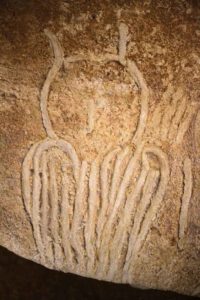 The later paintings include herbivores such as bison, horses, cattle and mammoths. From these, we know that there were two types of bison at this time: the steppe bison, genetically distinct from the American bison, with long horns, a large hump and strong quarters; and hybrid species with short horns and a slighter build, thought to have been the result of interbreeding between the steppe bison and aurochs (an extinct species from which the modern cow is descended). This is historically interesting because, although interbreeding between similar species is not unusual, it is uncommon for a hybrid to be able to reproduce.
The later paintings include herbivores such as bison, horses, cattle and mammoths. From these, we know that there were two types of bison at this time: the steppe bison, genetically distinct from the American bison, with long horns, a large hump and strong quarters; and hybrid species with short horns and a slighter build, thought to have been the result of interbreeding between the steppe bison and aurochs (an extinct species from which the modern cow is descended). This is historically interesting because, although interbreeding between similar species is not unusual, it is uncommon for a hybrid to be able to reproduce.
My personal favourites amongst the images are the horses, some of which can be seen to be whinnying. There is only one bird – a delightful owl. A second glance reveals that it shows the bird from the back – the painter must have been fascinated by its ability to twist its head through 180 degrees.
There are some oddities. One is a painting which could be the first image of an erupting volcano. A surprise is that there are no complete human figures, although there is a ‘Venus’ painting representing a vulva attached to an incomplete pair of legs. African and Aboriginal rock art, by contrast, have beautiful examples of dynamic hunting groups. But possibly the most remarkable painting is of a multi-limbed bison. For an explanation of this, watch this video I have made based on the work of Marc Azéme and Florent Rivère of the University of Toulouse-Le Mirail.
Background
In terms of evolution, 35,000 years ago Homo sapiens had stepped out of Africa to spread either east towards Asia or north through the then fecund Middle East and west into Europe. Here we met and interacted with Homo neanderthalis, destined to disappear but leaving all Europeans with between 2% and 6% of their genes. This period of interaction between these two species of humanity was vividly recreated by William Golding in his famous novel The Inheritors. In his introduction, John Carey says:
Golding explained that this Neanderthalis (the ‘people’ of the novel) are unfallen, because unlike the ‘new people’ (Homo sapiens), they cannot think; they can only imagine.
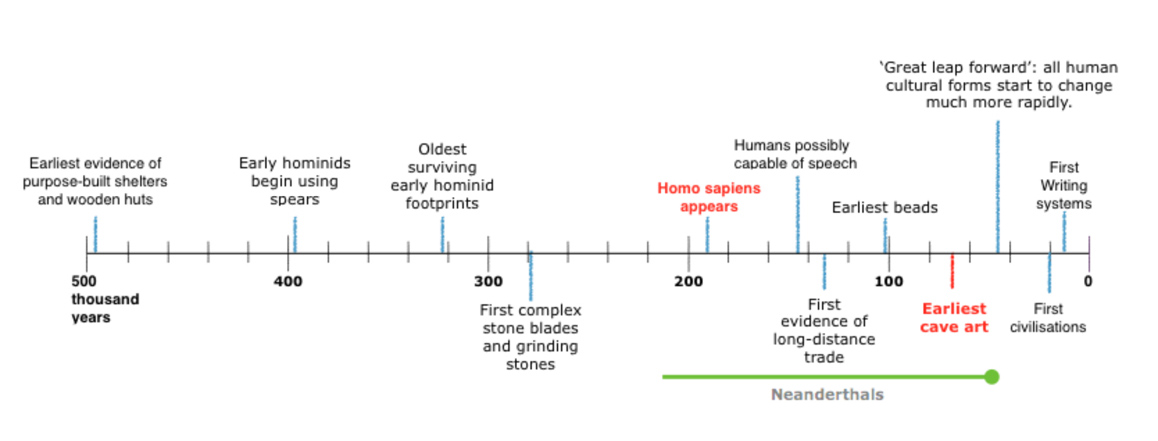
The conclusion to be drawn from this is that humankind at this time was between imagination and thought.
We had learnt by this time to build simple dwellings, to hunt with flint-tipped spears (but not the bow and arrow), to fashion and use tools, to sew clothes, to trade, and we had retained from our early primate forebears the desire to live in small social groups. We had learnt, in short, how to survive.
And it seems that we were already forming the Anthropocene age and affecting our environment. The Russian scientist, Sergey Zimov, who in 1988 created the Pleistocene Park experiment in Northern Siberia, proposes that the demise of large animals on the Russian steppes in the Pleistocene era was due less to climate change than to overhunting by human beings. He estimates that before we killed off most of the megafauna of the far north…
…on each square kilometre of pasture there lived one mammoth, five bison, eight horses, and fifteen reindeer. Musk ox, elk, woolly rhinoceros, antelope, snow sheep and moose were also present. Wolves, cave lions and wolverines occupied the landscape as predators. In total, over ten tons of animals lived on each square metre of pasture – hundreds of times higher than modern animal densities in the mossy northern landscape.

Chauvet Caves, lions. Photograph by Claude Valette, CC BY-SA 4.0, via Wikimedia Commons
Further down the road, we would develop farming, which meant villages, which led to more trade, which in turn allowed the development of towns and cities where writing was required to tally the goods. Civilisations formed and there were great migrations and conflicts…and so on to our present state, where we are beginning to wonder about the effect we are having on the world. Now we fear the extinction of beloved species – and even our own.
Anthropologists say that there are three basic requirements for human life: food, shelter and companionship. At the time of these first paintings at Chauvet, these requirements had been successfully met; and whilst life may have been short, it was not necessarily, as Hobbes famously supposed, “nasty and brutish”. We now think that people had more time for relaxation than we do now, and with such periods would have come the chance for contemplation of more abstract ideas than where to find the next meal. The night skies fascinated us, and understanding the natural world would have been fundamental to our survival. We could not write, but we made beads and flutes, told stories – and on cave walls, we painted.
Recent findings by Australian and Indonesian archeologists have suggested that this ability to paint existed not only in Europe, but also in Asia. For example, hand markings in the Maros-Pankep Caves on the island of Sulawes have recently been dated to 39,000 years old:
NEVER MISS AN ARTICLE
Please follow and like us:
CATEGORIES
Paintings of wild animals and hand markings left by adults and children on cave walls in Indonesia are at least 35,000 years old, making them some of the oldest artworks known…The work reveals that rather than Europe being at the heart of an explosion of creative brilliance when modern humans arrived from Africa, the early settlers of Asia were creating their own artworks at the same time or even earlier… Archaeologists have not ruled out that the different groups of colonising humans developed their artistic skills independently of one another, but an enticing alternative is that the modern human ancestors of both were artists before they left the African continent.
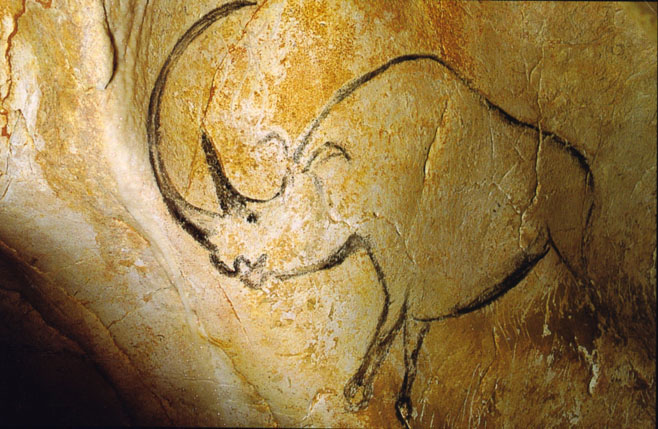
Chauvet Cave, rhinoceros. Photograph by Inocybe at French Wikipedia, via Wikimedia Commons
Thoughts
Many modern artists, notably Picasso, have been so impressed by the beauty and attention to anatomical detail of the cave artists that they have been influenced by these early examples, noting their strength and accuracy of line, and the delicacy of shading. Some, such as David Hockney, have even used them to question the idea that art progresses – causing Clive James to remark:
When Hockney says that ‘art doesn’t progress’ he is strictly wrong but effectively right, because he is still in daily touch with the original caveman defacing the first wall back in Lascaux.
That so many people find the paintings beautiful is attested to by their inclusion in so many coffee-table books, and the number of visitors to the Chauvet site every year. But why were they painted? Today, of course, we appreciate art for its own sake, but can we ascribe this motivation to these very first painters? After all, they had no tradition with which to compare their work.
There are several theories regarding the motives of these first cave artists. An exhibition in 2016/17 (still current at the time of publishing) at the Museum of Old and New Art in Tasmania exploring ‘The Origins of Art’ has suggested that they were a message to the future, or a way to attract mates. This latter idea was roundly refuted by Jonathan Jones in his review of the event:
The art of the ice ages such as those in Niaux has the same qualities as the art of Rembrandt, Da Vinci and Picasso, and is as hard to reduce to a simple biological urge or obvious evolutionary need. At its point of origin in the dark caves deep in the Earth, art is enigmatic, poetic, profound and dreamlike. You can’t explain it until you can also explain Mark Rothko’s Seagram murals.
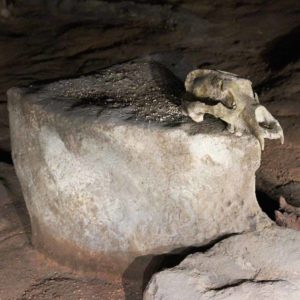 A more plausible explanation is that they were shamanistic or animistic. The fact that the paintings were hidden in hard-to-get-to places – meaning that they were not accessible to everyone – would perhaps support this theory. Could they have been placatory in some way – a petitionary prayer to the predators? “See how we revere you! How could you hurt someone who sees you like this?” The presence of a bear skull found on what looks like a natural rock altar would seem to indicate this kind of reverence and the attribution of power.
A more plausible explanation is that they were shamanistic or animistic. The fact that the paintings were hidden in hard-to-get-to places – meaning that they were not accessible to everyone – would perhaps support this theory. Could they have been placatory in some way – a petitionary prayer to the predators? “See how we revere you! How could you hurt someone who sees you like this?” The presence of a bear skull found on what looks like a natural rock altar would seem to indicate this kind of reverence and the attribution of power.
However, almost every known form of animism includes not only animals but also particular trees and rocks which are considered to be objects of spiritual power. If the object at Chauvet was animistic, why are there no paintings of these? And why are there no human figures, when in Africa and Australia humans were expressed with such vitality?
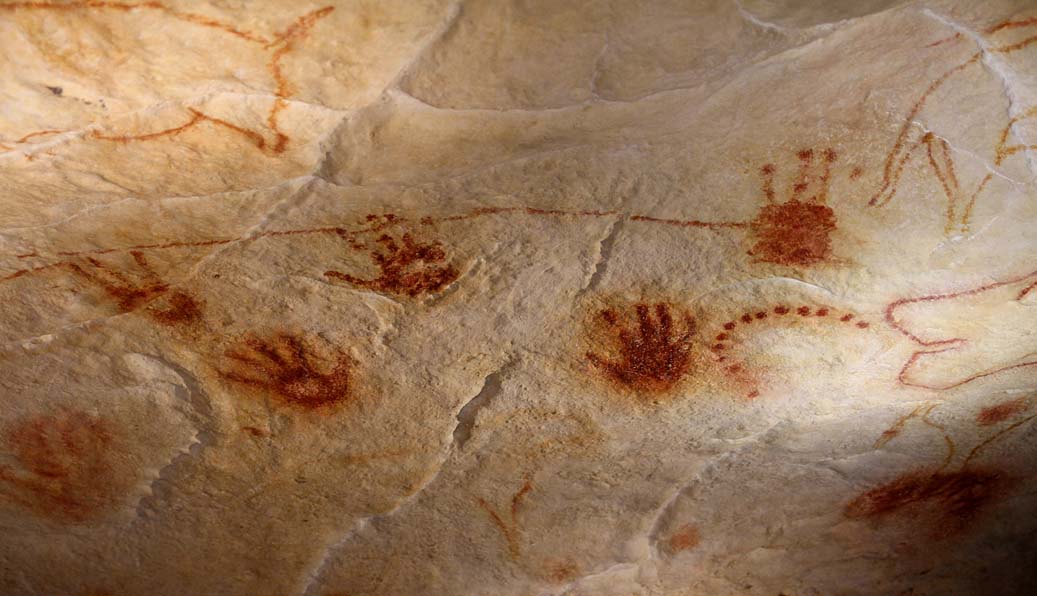
Chauvet Cave: handprints. Photograph by Claude Valette (own work), CC BY-SA 4.0, via Wikimedia Commons
Another idea is that the development of cave art was a way of coping with the Ice Age which stretched from about 35,000–15,000BCE. It was during this 15–20,000-year period that this kind of artistic expression reached a critical mass, not only in Europe but also in Asia, Siberia, Australia and Africa. The most intense artistic activity seems to have occurred just as conditions reached their most severe, and then about 10,000 years ago, it virtually disappeared. But if people made art to help them survive the Ice Age world, how did it do this? (For more on this see the Institute for the Study of Human Knowledge).
The prehistorians Jean Clottes and David Lewis-Williams, studying Paleolithic cave art in both Europe and Africa, have proposed that these images were created as part of a process by which imaginative visions and internal states of consciousness were projected onto the cave walls and ceilings. In his film about Chauvet, ‘The Cave of Forgotten Dreams’, Werner Herzog similarly suggests that the drawings were an image of inner landscape, drawn near the Pont d’Arc because this was an important feature for these people. One team member suggests that Homo spiritualis would be a better name for us than Homo sapiens.
But whatever theories we come up with, the fundamental fact is that with these paintings, we created/discovered art. We can try to explain them in modern academic terms, but such understandings concern details and do not approach the heart of the matter. Surely at the heart of their mystery lies a spiritual quest for understanding and self-identification within our environment, and knowledge of our place in it, forever fuelled by our need for something better.
We also attempt to explain our modern appreciation of these ancient images, but do we need to do this? Searching for some way to draw a conclusion to this piece, I came across this from a previous Beshara Magazine article by Barbara Vellacott:
Why then do we even attempt to describe the beauty that is indescribable when we know that it is so? This brings us back to reflection, and the memory of moments of vision that are gone. Such moments leave their trace and we are not as we were.
To which I add this stanza from Fitzgerald’s translation of The Rubaiyat of Omar Khayyam:
Then to the rolling Heav’n itself I cried
Asking: ‘What Lamp had Destiny to guide
Her little children stumbling in the Dark?’
And ‘A blind understanding’ Heav’n replied.
Email this page to a friend
Email this page to a friend
Image Sources
Banner: Chauvet Cave, Etologic Horse Study. Photograph by Thomas T, CC BY-SA 2.0, via Wikimedia Commons
First Inset Image: Chauvet Cave, horses and bison. Photograph by Nachosan, CC BY-SA 3.0, via Wikimedia Commons
Second Inset Image: Chauvet Cave, owl. Photograph by Claude Valette, CC BY-SA 4.0, via Wikimedia Commons
Third Inset Image: Chauvet Cave, carefully placed bear skull. Photograph by Claude Valette, CC BY-SA 4.0, via Wikimedia Commons
Other Sources (click to view)
For a virtual tour of the caves, and much other information, see http://archeologie.culture.fr/chauvet/fr/grotte-chauvet-pont-arc
Jean Clottes quoted in https://en.wikipedia.org/wiki/Chauvet_Cave
Marc Azéme and Florent Rivère ‘Animation in Palaeolithic art: a pre-echo of cinema’ in Antiquity, 86/332, June 2012.
Sergey Zimov quoted in ‘Rethinking Extinction’ by Stewart Brand, Aeon, April 21, 2015. http://reviverestore.org/rethinking-extinction/
William Golding, The Inheritors (Faber and Faber, London, 1955)
Ian Sample, ‘35,000-year-old Indonesian cave paintings suggest art came out of Africa’, The Guardian, 8th October 2014. https://www.theguardian.com/science/2014/oct/08/cave-art-indonesia-sulawesi for the full article and a short video documenting these findings.
Clive James, ‘A History of Pictures by David Hockney and Martin Gayford review’, The Guardian, 19th October 2016. https://www.theguardian.com/books/2016/oct/19/a-history-of-pictures-by-david-hockney-and-martin-gayford-review
Jonathan Jones, ‘God, sex or evolution – why did human beings start making art’. https://www.theguardian.com/artanddesign/jonathanjonesblog/2016/nov/03/on-the-origins-of-art-exhibition-tasmania-why-did-humans-start-making-art-comment
Institute of the Study of Human Knowledge: The Human Journey – Pre-Axial Thought. http://ishk.com/HumanJourney/FirstHumanArt/?gclid=CIqyrovPt9ICFdgRaAod0JcOxw
Werner Herzog, Cave of Forgotten Dreams, film released 2010. Available as a video on https://www.youtube.com/watch?v=yoSBMdAh_eY
‘A Thing of Beauty – Barbara Vellacott contemplates the indescribability of beauty in Dante’s Paradiso’, Beshara Magazine, January 2016
 Graham Falvey studied Anthropology and Religious Studies at the University of Wales, and for some years worked with Alan Ereira as the administrator for the Tairona Heritage Trust which supports the Kogi Indians in Colombia. In this capacity, he visited the community on two occasions. He worked mainly as a gardener and Estate Manager in his early life, and is presently teaching English in Hanoi, Vietnam. Graham died in 2018 and is much missed by his friends and colleagues all over the world.
Graham Falvey studied Anthropology and Religious Studies at the University of Wales, and for some years worked with Alan Ereira as the administrator for the Tairona Heritage Trust which supports the Kogi Indians in Colombia. In this capacity, he visited the community on two occasions. He worked mainly as a gardener and Estate Manager in his early life, and is presently teaching English in Hanoi, Vietnam. Graham died in 2018 and is much missed by his friends and colleagues all over the world.
NEVER MISS AN ARTICLE
If you enjoyed reading this article, please leave a comment below.
Please also consider making a donation to support the work of Beshara Magazine. The magazine relies entirely on voluntary support. Donations received through this website go towards editorial expenses, eg. image rights, travel expenses, and website maintenance and development costs.
Please follow and like us:
READ MORE IN BESHARA MAGAZINE:


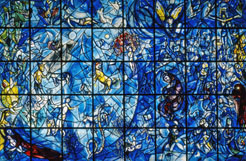

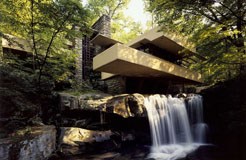
0 Comments